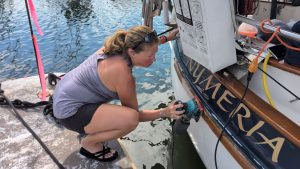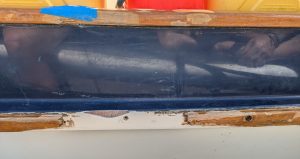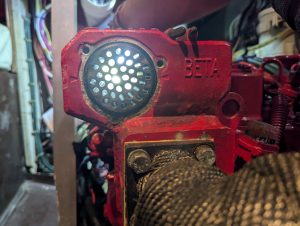We’ve discovered a problem. It seems our batteries have died somehow. “But Justin, didn’t you just spend a whole bunch of time and money replacing them?” “Why yes dear reader, we did.” That’s the most troubling part. The batteries and whole charging system is brand new. Its a head scratcher for sure. So lets dig into it.
WARNING: Lots of boring technical details to follow, if that isn’t your thing, here a pretty picture of the Nymeria, and we will see you next week 🙂

We started seeing the issue a few months back, just after Harvest Moon. One evening we were just relaxing after dinner and suddenly all the power went out on the boat. Turns out the new inverter had just shut down due to low battery voltage. Searching for the cause I found that I had turned off the inverter/charger breaker. This mean we had been running the whole boat purely on the batteries with no charging for who knows how long. I didn’t flip the breaker in purpose (that I do regularly for testing), but it is not unreasonable to accidentally flip it becasue all the breakers are right here next to my desk. For the batteries to be that low, it must have been days without me noticing. This didn’t seem likely because all the gauges and displays are right next to me while I work and I’m a data junkie so I’m always looking at them. Once I reset the charger and reconnected, everything went back to normal. Several weeks go by without issue, though keep in mind were at the dock and always plugged in so we don’t use the batteries and they are always getting a basic float charge to keep them full.
One day I get another itch to do some testing, I wanted to see if I can make a whole loaf of bread using the breadmaker all on the batteries, and then fully recharge with the solar panel. After doing the math, it should certainly work. The breadmaker at max pulls about 600w @ 110v, its not always running at full in its 3 hour cycle, but even it did it should only pull about 195Ah out of the system. (600w = ~65 amps @ 12v factoring in some losses in the inverter, over 3 hours = 195Ah.) With 465 Ah to work with I should have plenty to spare. Me being me, I had disconnected the charger the night before so the batteries were at about 95% when I started. Turns our my estimates were way off. In the end, while it did in fact pull about 70 amps from time to time it was very rare over the 3 hour period. In total it pulled about 50Ah. But right as the bread was finishing The inverter shuts off again with a low battery warning. Now I had been watching closely, and the batteries should be nowhere near that low. The state of charge (SoC) still read 80% and the voltage while not under load was happy at 12.5v. The low voltage cutoff on the inverter is 10.8v and while 70 amps is a reasonably big draw its well within range. At full bore, the 2000w inverter can pull over 160 amps. The batteries should be more than capable to handling it without dropping the voltage that low.

At this point I’m still thinking its operator error, and I’m expecting too much from the batteries. Another few weeks go by with no issues until I get another “lets do some testing” bug. We had recently replaced our refrigerator, and installed a new portable 12v cooler we are using as a freezer. So now that they were installed and running at their steady state I wanted to see how much more power having both of them running would take, and make sure our solar could handle the load. With the batteries at 100% I shut down the charger just as the sun sets. I check voltages and loads and everything is working fine. In-fact, even with both fridge and freezer running its only drawing about 7 amps, the old fridge itself used to pull 5-6 amps. Overnight the old fridge would use about 45Ah, and was easily recovered by the solar the next day.
The next morning I check the system and it looks great. The sun is coming up and overall we had only used about 53Ah, and the batteries were at 12.5v and ~85% SoC. The solar should have no problem recharging this as its only barely more than the old one. Then I started filling the kettle for tea. As soon as the water pump kicks on and starts drawing 8 amps, the lights dim, and I see the battery voltage drop to 11.5v. Now I know something is up. We should be able to run these batteries down to 30%/11.8v with no issues. Why are they acting dead when they should still have plenty of power? I did all the basic testing I could. I looked at all the connections, they were all tight and looked clean. I tested each battery with my manual multimeter, and they tested just fine and matched the 12.4v readings the system was telling me. But, as soon as any load is put on them the voltage drops off a cliff.
I called up the big guns. Brent, who had done the whole electrical install and even recommended the batteries to me was stumped with what he was hearing. He was intrigued enough that he came by to test everything he could. We started with the basics, connections, voltages, charger settings. He just confirmed what I had looked at and everything seemed fine there. The batteries were full at that point so we needed to see them go bad. I had told him that they always seems to fail at about -50Ah, and about 12.4v. We disconnected both the main charger and the solar, and plugged in a heat gun and just let it rip. We were working the batteries hard, ~80-90 amps and they are doing great. Even pulling that much they hold steady at 12.5v. Stop the draw and they recover to 12.6. So we keep cranking, we need to burn up ~50Ah, or about 30 minutes at that draw. Sure enough, as soon as the batteries hit -53Ah, the floor drops out. Even a minor 3 amp draw will pull them immediately down to 11.5v and keep dropping. but as soon as we stop the load, they recover to 12.4. Right where they should be.
Now he’s confused. He has installed 50+ of these batteries and never had an issue with them. He doesn’t even now how to test them as he has never needed to. He pulls out his normal battery tester, and we run some tests. A normal AGM battery should be able to produce ~900 cold cranking amps, so he assumes these should as well as they are just and advanced AGM. We isolate the first battery and run the test. “REPLACE BATTERY” it reads. Seems it could only pull 11 CCA. He has never seen a battery test that bad. We isolate another battery and test it. 12 CCA. That’s two of the worst he has ever seen, and cant believe it. We isolate and test the last two, with 21 and 22 CCA. Either this is not a good test for these batteries, or we really have 4 totally failed ones.
What could have caused these failures? All of the charging systems are brand new, and configured to the specs provided by Firefly. 14.4v absorb charge, until charge rate is 1.5 amp per battery, then 13.4v float. The main charger even has a full charge rest mode that shuts off the float charge to let the battery settle to 12.8v from time to time so it doesn’t sit at float forever. We also have the solar set to a matching charge profile. the only difference here is it will do a full absorb charge every day, but that’s what most, if not all, solar chargers do. None of that should have cause them to die. I certainly have not been abusing the batteries. Its only recently they’ve ever hit the low voltages that might cause harm, but they are immediately charged again and don’t sit there to cause the any internal damage. They are inside the boat, so its not an environmental thing. We are just at a loss for what could have caused this.
Now we wait. Brent is working with Firefly to see whats up, and they admit that from time to time they have a bad batch, but its exceedingly rare for one of their batteries to fail, much less 4.






Love the ratchet strap hold-down ?
It’s quite effective! They don’t move at all.